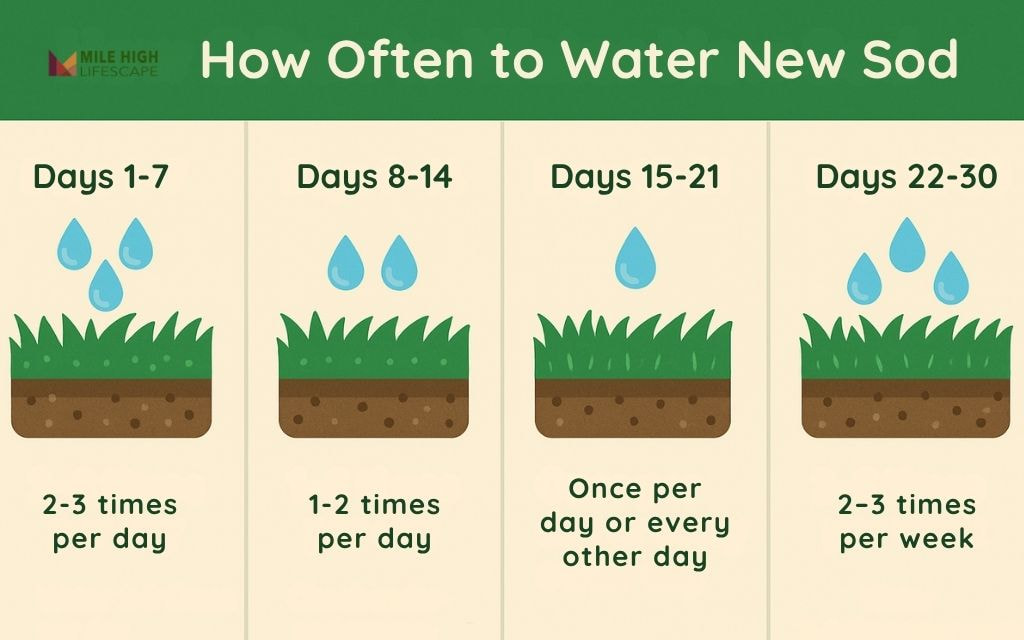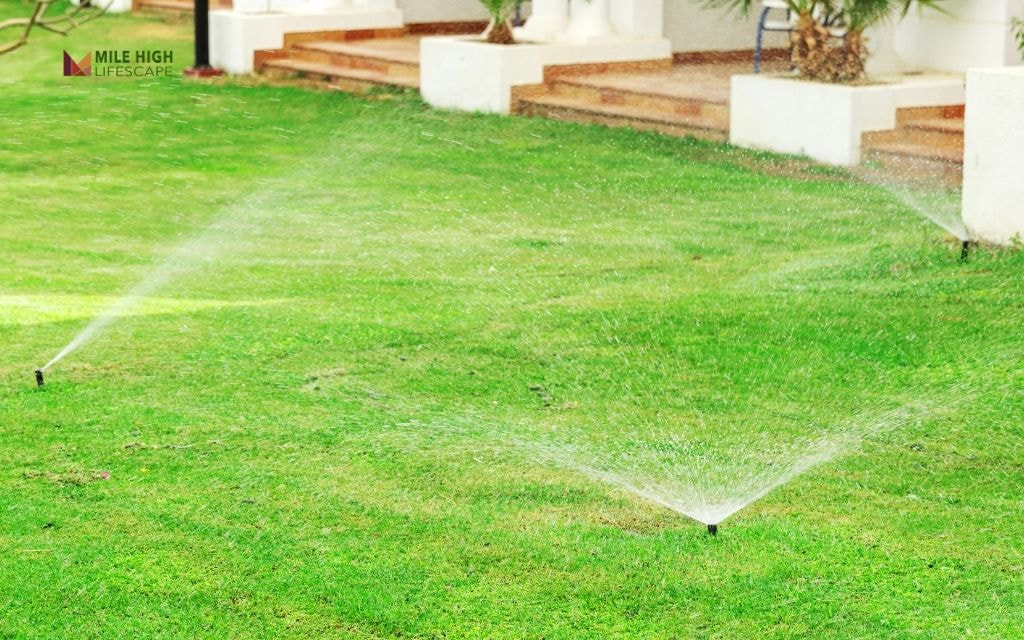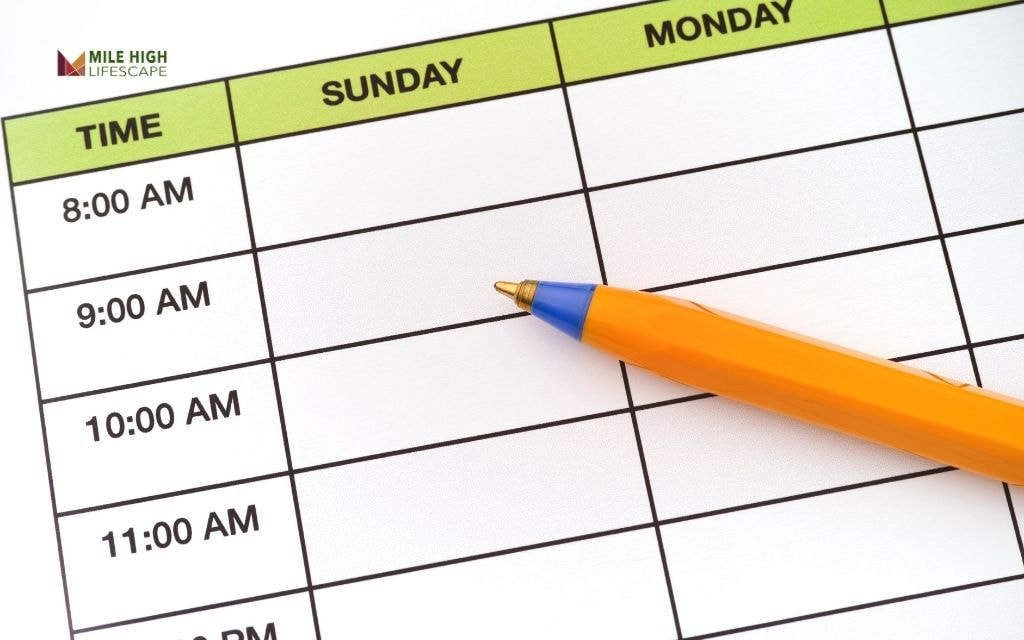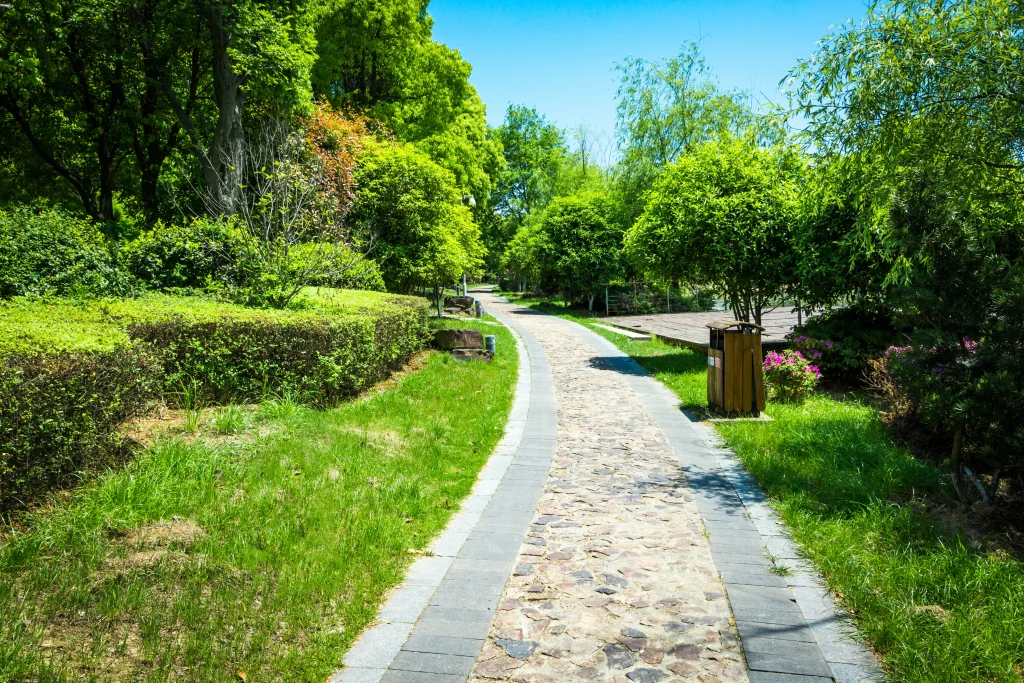How often to water new sod? Newly laid sod requires several waterings daily for the first 2 weeks, gradually reducing to once daily and then 2-3 times weekly as roots establish. This careful watering schedule ensures the successful establishment of your new sod.
New sod represents a significant investment in your property’s value and appearance. The success of this investment hinges on proper watering during the critical establishment period. Without adequate moisture, your sod will struggle to develop the root system it needs to thrive in Denver’s challenging climate.
This guide provides specific watering instructions, covering frequency, timing, volume, seasonal adjustments, and troubleshooting common issues. Following these guidelines will help your new sod establish quickly while complying with local water conservation efforts.
How Often to Water New Sod?
The watering frequency for new sod changes as the roots begin to establish. Here’s a comprehensive schedule designed specifically for Denver’s climate:
| Time Period | Watering Frequency | Purpose & Notes |
| Days 1–7 | 2–3 times per day | Maintain consistent moisture in sod and soil (not soggy). Essential for root contact with soil and preventing desiccation. |
| Days 8–14 | 1–2 times per day | Begin reducing surface watering while maintaining deeper soil moisture. Check for early signs of rooting. |
| Days 15–21 | Once per day or every other day | Water deeper but less frequently to encourage downward root growth. Test rooting progress by gently lifting a corner of sod. |
| Days 22–30 | 2–3 times per week | Deep, infrequent watering promotes stronger root development and drought resilience. |
During hot, dry periods with temperatures above 85°F, you may need to add an extra watering session. Conversely, reduce frequency during cool or rainy periods. Use a soil moisture probe to check whether water is reaching 6-8 inches deep, the target zone for developing roots.
Pay special attention to edges and corners, which dry out faster than the main sections. These vulnerable areas often require supplemental hand watering, particularly during the first week after installation.
Taking care of your new sod is not easy! That’s why we provide many helpful tips to care for your sod in this guide.

Best Time of Day to Watering New Sod
The timing of your watering sessions significantly impacts sod establishment success in Denver’s unique climate. Strategic scheduling maximizes water absorption while reducing waste and preventing disease development.
Early Morning (Ideal)
Watering between 5:00 AM and 9:00 AM provides ideal conditions for new sod in Denver:
- Temperatures remain cool, minimizing evaporation loss
- Wind speeds are typically at their lowest, ensuring even water distribution
- Morning dew contributes additional moisture, enhancing watering efficiency
- Water absorption occurs before midday heat stress begins
- Grass blades dry completely during daylight hours, reducing disease risk
- Denver water pressure often peaks during early morning, improving sprinkler performance
For automatic irrigation systems, program your first cycle to complete before 9:00 AM. If watering manually, start as early as practical within this window.
Midday (Avoid)
Avoid watering between 10:00 AM and 6:00 PM for these Denver-specific reasons:
- Denver’s mile-high elevation increases UV intensity by approximately 25%
- Midday evaporation rates can waste up to 30% of applied water
- Wind speeds typically increase during afternoon hours, causing uneven distribution
- Water droplets on grass blades can magnify sunlight, potentially burning new grass
- High water bills result from inefficient daytime watering
- Denver Water restrictions often specifically prohibit midday watering
If you notice dry areas developing during extreme heat, consider targeted hand watering of affected spots rather than running full irrigation cycles.
Evening (Optional)
Evening watering (7:00 PM to 10:00 PM) presents both benefits and risks:
- Lower temperatures and wind reduce evaporation compared to midday
- Allows sod to enter overnight hours with adequate moisture
- HOWEVER: Grass remaining wet overnight promotes fungal disease development
- Denver’s high diurnal temperature swing creates heavy dew that compounds overnight moisture
If evening watering becomes necessary during extreme heat:
- Complete all watering before 7:00 PM when possible
- Apply lighter volumes than morning sessions
- Focus on areas showing stress signs
- Resume morning-only watering as soon as temperatures moderate
How Much Water Does New Sod Need?
New sod in Denver requires specific water volumes that change throughout the establishment period. Understanding these requirements helps ensure successful rooting while conserving water.
First Week Requirements
During the first week after sod installation, new sod needs approximately 1-1.5 inches of water daily. This volume ensures moisture penetrates through the sod layer and into the soil beneath, creating ideal conditions for initial root development. The goal is to keep both the sod and the top 1-2 inches of soil consistently moist.

Measuring Water Output
To determine how long to run your irrigation system:
- Place several flat containers (tuna cans work well) across different lawn zones
- Run your sprinklers for exactly 15 minutes
- Measure water depth in each container
- Calculate the average depth collected
- Determine how long to run your system to achieve the 1-1.5 inch target
For example, if your system delivers 0.5 inches in 15 minutes, you’ll need to run it for 30-45 minutes total each day (divided into multiple sessions).
Adjusting Volume as Roots Develop
As your sod establishes, the watering strategy should evolve:
- Weeks 1-2: Maintain 1-1.5 inches daily, divided into multiple sessions
- Weeks 3-4: Increase to 1.5-2 inches total, but applied less frequently (every other day)
- Weeks 5+: Apply 1.5-2 inches twice weekly, encouraging deeper root penetration
This gradual transition to deeper, less frequent watering encourages roots to grow downward, creating drought resistance that’s essential for long-term lawn health in dry spells.
How to Watering New Sod?
Follow these precise steps to establish your new sod successfully in Denver’s unique climate:
- Test sprinkler coverage before installation. Place cups in a grid pattern and run your system to verify even water distribution. Adjust sprinkler heads to eliminate dry spots or excess overlap.
- Begin watering immediately after the first section is installed. Don’t wait until the entire lawn is completed. New sod begins drying within 30 minutes of installation.
- Water thoroughly until the soil beneath becomes saturated. This initial watering requires significantly more water than subsequent sessions.
- Implement cycle-and-soak for sloped areas. Water for 5-10 minutes, pause for 30 minutes to allow absorption, then repeat. This prevents runoff and ensures water reaches the root zone.
- Check moisture penetration daily using a screwdriver test. The tool should easily penetrate 6 inches into properly watered sod. Resistance indicates insufficient moisture.
- Inspect sod edges and corners twice daily during the first week. These areas dry faster and often require supplemental hand watering.
- Monitor for signs of rooting starting on day 10. Gently lift a corner of sod – resistance indicates root development has begun. Begin transitioning to less frequent, deeper watering once resistance is felt.
- Adjust watering times weekly based on weather conditions and visible lawn response. Slight yellowing may indicate overwatering, while curling or blue-gray coloration suggests underwatering.
How to Adjust Your Watering Schedule Based on Season?
Denver’s seasonal variations significantly impact watering requirements for new sod:
Summer Installation (June-August)
Summer presents the most challenging conditions for new sod in Denver. Higher temperatures, intense UV radiation, and periodic hot, dry winds increase evaporation rates dramatically.
- Increase watering frequency to 3-4 times daily during the first week
- Schedule the first watering before sunrise (4:00-5:00 AM)
- Add a light evening watering (7:00-8:00 PM) during extreme heat periods
- Monitor soil moisture twice daily, especially during hot spells
- Consider temporary shade structures for south-facing slopes
- Transition to deep watering more gradually than in other seasons
Spring/Fall Installation (March-May/September-October)
These moderate seasons offer ideal conditions for new sod establishment in Denver:
- Follow the standard watering schedule outlined earlier
- Adjust for seasonal weather patterns – spring brings wet snow, fall brings dry weather
- Spring installation requires monitoring for late freezes
- Fall installation needs additional water to compensate for dry autumn winds
- Begin reducing watering frequency sooner than summer installations
- Transition to normal maintenance watering within 3-4 weeks
Winter Installation (November-February)
Winter installation poses unique challenges but remains possible in Denver’s relatively mild winter climate:
- Water only during temperatures above 40°F
- Apply water mid-morning (10:00 AM-1:00 PM) when temperatures peak
- Reduce overall water volume to prevent freezing damage
- Monitor for extended freezing periods that prevent watering
- Expect slower establishment and a longer transition to normal watering
- Resume regular watering schedule when spring temperatures arrive

Troubleshooting Common Watering Mistakes
Even with careful attention, watering challenges can emerge when establishing new sod in Denver. Recognize and address these common issues:
Underwatering
- Symptoms: Curling grass blades, blue-gray coloration, footprints remaining visible, corners lifting
- Solutions: Increase watering frequency immediately, focus on problematic areas with hand watering, apply water in shorter cycles to improve absorption, check sprinkler coverage for dry spots
Overwatering
- Symptoms: Soggy soil, squishing sound when walked on, fungal growth, yellowing grass
- Solutions: Reduce watering frequency while maintaining adequate moisture, improve drainage in problem areas, water in early morning only, verify sprinkler output isn’t excessive
Water Runoff
- Symptoms: Water pooling or running off slopes before absorbing
- Solutions: Implement cycle-and-soak method (water 5-10 minutes, rest 30 minutes, repeat), aerate compacted areas, consider wetting agent products for severe clay soil
Drying Edges and Corners
- Symptoms: Edges curl up, corners turn brown
- Solutions: Hand water edges twice daily, adjust sprinkler coverage to reach boundaries, consider temporary sprinklers specifically for perimeter areas
Conclusion
The first month of sod care establishes the foundation for years of lawn health. By following Denver-specific watering practices, you create conditions for deep root development, drought resilience, and long-term vitality.
Remember that proper watering represents the most crucial factor in new sod success – more important than fertilization, mowing, or any other maintenance practice during establishment.
The investment of time and attention during these critical weeks yields dividends through reduced water needs, fewer pest issues, and minimized maintenance requirements for years to come.
For professional assistance with sod installation and maintenance in Denver, contact Mile High Lifescape in Denver at (303) 877-9091. Our experienced team provides comprehensive lawn services tailored to Denver’s unique conditions.
Frequently Asked Questions (FAQs)
How often should I water newly laid sod?
Newly laid sod requires watering 2-3 times daily during the first week. Water each morning, midday, and early evening to maintain consistent moisture. After 7-10 days, reduce to 1-2 times daily, then gradually transition to deeper, less frequent watering as roots establish.
Can you overwater new sod?
Yes, overwatering new sod creates as many problems as underwatering. Excessive moisture prevents oxygen from reaching developing roots, potentially causing root rot and fungal diseases. If you observe standing water, soggy conditions, or a spongy feel underfoot, reduce watering frequency while maintaining adequate moisture.
How long does it take for sod to take root?
Sod develops initial roots within 10-14 days in Denver’s climate, with complete establishment taking 4-6 weeks during the growing season.
How do I know if I am overwatering my new sod?
Overwatered sod shows specific symptoms. The soil feels soggy, and walking on the lawn creates waterlogged depressions that don’t spring back. The grass may develop yellowish patches, and you might notice mushrooms or other fungal growth. A foul odor can indicate anaerobic conditions from excessive moisture.
Is it normal for new sod to turn brown?
Yes, new sod may develop some browning during establishment, particularly at the edges where drying occurs fastest. Slight yellowing often represents transplant shock and typically resolves within two weeks. However, widespread browning indicates serious water issues requiring immediate attention.
